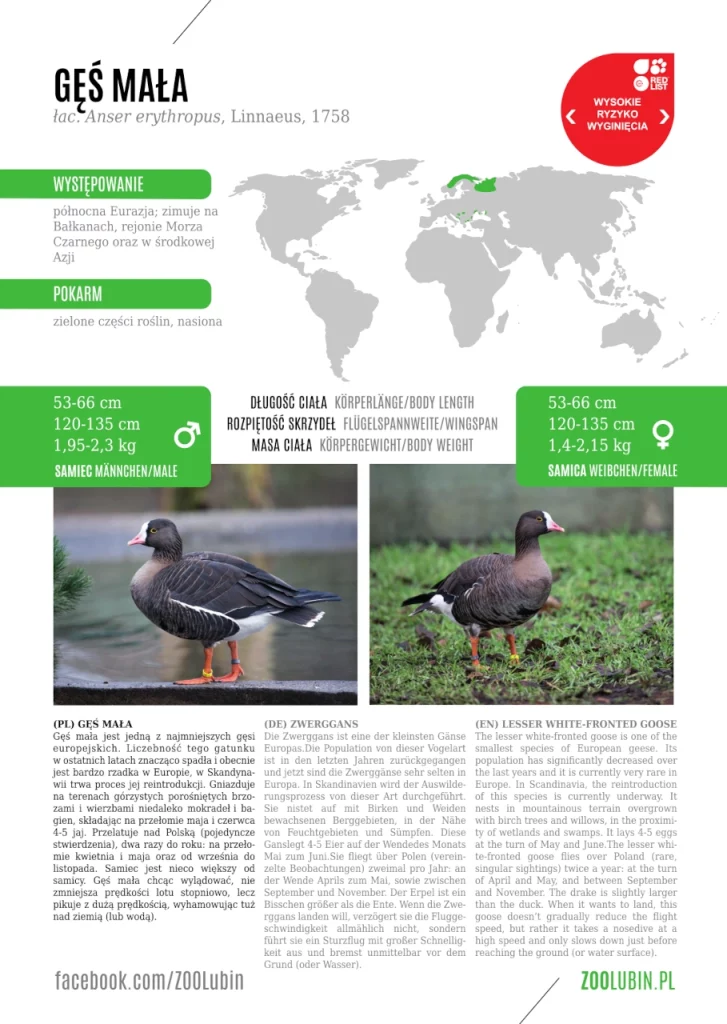
POBIERZ ETYKIETĘ GATUNKOWĄ – PLIK PDF (rozmiar 2206 KB)
Gęś mała (PL)
łac. Anser erythropus, Linnaeus, 1758
Gęś mała jest jedną z najmniejszych gęsi europejskich. Jak każdy ptak wodny preferuje tereny wokół rzek i jezior. Przelatuje nad Europą dwa razy w roku: na przełomie kwietnia i maja oraz od września do listopada. Wygląd samca i samicy jest podobny. Gniazduje na ziemi, składając 4–5 jaj w maju lub czerwcu. Samica wysiaduje jaja, a po wykluciu się młodych do opieki nad nimi dołącza samiec. Chcąc wylądować, gęś mała nie zmniejsza prędkości lotu stopniowo, lecz pikuje z dużą prędkością i wyhamowuje tuż nad ziemią (lub wodą).
Występowanie: północna Eurazja; zimuje na Bałkanach, w rejonie Morza Czarnego oraz w środkowej Azji
samiec / samica
Długość ciała: 53–66 cm
Rozpiętość skrzydeł: 120–135 cm
Masa ciała: 1,95–2,3 kg / 1,4–2,15 kg
Zwerggans (DE)
łac. Anser erythropus, Linnaeus, 1758
Die Zwerggans ist eine der kleinsten Gänse Europas. Wie alle Wasservögel, bevorzugt sie Gebiete in der Nähe von Flüssen und Seen. Sie fliegt über Europa zweimal pro Jahr: um die Wende Aprils zum Mai sowie zwischen September und November. Das Aussehen von beiden Geschlechtern ist sehr ähnlich. Diese Gans nistet auf der Erde und legt 4–5 Eier im Mai oder Juni. Das Weibchen brütet die Eier aus, und nachdem die Jungen ausschlüpfen, stößt der Erpel zur Kükenbetreuung dazu. Wenn die Zwerggans landen will, verlangsamt sie die Fluggeschwindigkeit allmählich nicht, sondern führt einen Sturzflug mit großer Schnelligkeit aus und bremst unmittelbar vor dem Grund (oder Wasser).
Vorkommen: nördliches Eurasien; im Winter auf dem Balkan, in der Schwarzmeerregion und in Zentralasien
Männchen / Weibchen
Körperlänge: 53–66 cm
Flügelspannweite: 120–135 cm
Körpermasse: 1,95–2,3 kg / 1,4–2,15 kg
Lesser white-fronted goose (EN)
łac. Anser erythropus, Linnaeus, 1758
The lesser white-fronted goose is one of the smallest geese in Europe. Like all water birds, it prefers to stay in the proximity of rivers and lakes. It flies over Europe twice a year: at the turn of April and May, and between September and November. Drakes and ducks look alike. This goose nests on the ground. It lays 4–5 eggs in May or June. The female incubates the eggs and after the chicks hatch, the male joins in taking care of the young. When it wants to land, the lesser white-fronted goose doesn’t gradually slow down, but rather it takes a nosedive at a high speed and only decelerates just before it reaches the ground (or water surface).
Distribution: northern Eurasia; in winter: the Balkans, the Black Sea region and Central Asia
male / female
body length: 53–66 cm
wingspan: 120–135 cm
body mass: 1,95–2,3 kg / 1,4–2,15 kg
